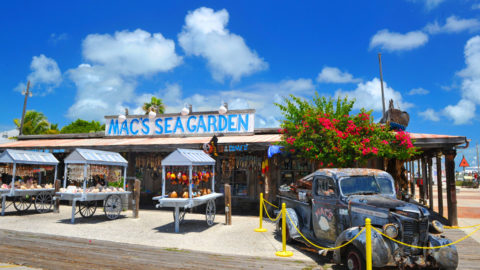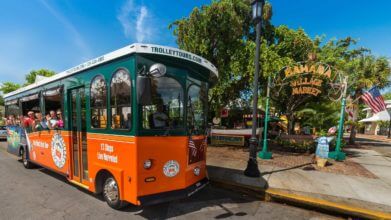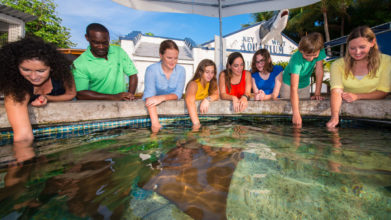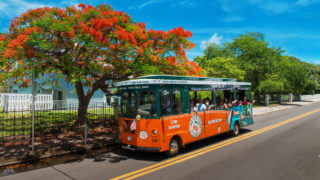Fun Facts About Key West

Key West Facts
To most, Key West is thought of as a beach town with great parties, endless sandy coastline and year-round sunshine. But did you know its history stretches much farther than its shoreline? Read on for some of the best fun facts about this island oasis.
Learn how to pronounce “Conch”
is pronounced kȯŋk with a hard “K”
Conchs aren’t just pretty pink seashells.
In Key West, conchs are people born in Key West. You’re not considered a conch by simply living in Key West; but if you’ve been a local for at least seven years, you may be considered a “freshwater conch” in some circles.
The Age of Sail
The Age of Sail ended in the 1820s as steam power gained popularity, particularly during the Civil War in the 1860s. Despite this shift, sailing remained important in Key West’s industry until the construction of its final ship.
Key West chickens.
Yes, that’s a rooster you hear crowing at dawn and that’s a hen with her chicks crossing Duval Street. Key West has a healthy population of chickens that roam free on the island. And it’s been that way for decades. Some people find them a nuisance, others charming. Either way, they’re not going anywhere.
Key West is closer to Cuba than Miami.
As it’s famously stated on the Southernmost Buoy at the end of Simonton Street, Key West is 90 miles to Cuba. But to get to Key West from Miami, it’s a 150-mile drive down the Overseas Highway.
Forty-two bridges connect Key West to the mainland.
The Overseas Highway is one of the most beautiful drives in the country. Completed in 1938, it connects a string of keys and coral rock with 113 miles of concrete roadway. The aptly named Seven Mile Bridge is the longest and most scenic.
The Overseas Railroad came first.
The Overseas Railroad operated from 1912 to 1935 and you can still see remnants of the original track on the drive down to Key West today. It was mostly destroyed during the devastating hurricane of 1935, often called the storm of the century.
The sunset is celebrated every night in Mallory Square.
Key West is famous for its sunset and there’s no place like Mallory Square to celebrate every night amongst street performers, musicians and food stands. A sunset sail is another fantastic way to enjoy the gifts of Mother Nature at sunset.
Forty-one degrees is the record low temperature in Key West.
This occurred twice since temperatures were recorded starting in 1873 on January 13, 1981 and January 12, 1886. Since it’s never reached freezing, there’s also never been snowfall in Key West. On average, you can expect temperature highs in the 70s to 80s year round with low temperatures in winter dipping into the 60s and sometimes 50s.
Key West was home to Ernest Hemingway and many other famous writers.
Papa spent his most prolific writing years in Key West during the 1930s and some say Key West has inspired more writers per capita than any other American city. Other famous scribes who called Key West home include Tennessee Williams, Shel Silverstein, Robert Frost, Elizabeth Bishop and more.
Key West is home to the third largest barrier coral reef in the world.
Known as the Florida Straits, Key West’s coral reef extends 150 miles north towards Miami and 70 miles west to the Dry Tortugas. It’s the largest in North America and the third largest in the world behind Belize and the Great Barrier Reef in Australia.
The Atlantic Ocean and Gulf of Mexico meet here.
Key West’s diverse and unique ecosystems are a result of the convergence of two major bodies of water. You’ve got the deep blue Atlantic and its Gulf Stream current to the south and the shallow flats of the Gulf of Mexico to the west.
“Jimmy Buffett doesn’t live in Key West anymore.”
While these are the lyrics of an oft-quoted David Allan Coe song, they also ring true. While there’s a home on Windsor Lane believed to be owned by Buffett, he’s no longer a Key West local. But Parrot Heads can always gather at Margaritaville.
But Judy Blume does!
Beloved young adult author Judy Blume has called Key West home for many years and is a big part of the local creative community.
Key West was once the richest city in the United States per capita.
Key West made its riches from wrecking and salvaging ships that crashed on the reefs and shallow waters offshore. Locals made their riches auctioning off or reselling the valuable cargo.
Shipwreck recovery was an early industry.
And so was sponging, fishing, turtling and salt manufacturing. Today, Key West thrives on tourism, which is also largely based on the bounties of the water.
Duval Street is a mile long pub crawl.
Lined with more bars than you can count, a Duval crawl is a must during a visit to Key West. Duval Street is also home to many restaurants and shops.
Key West’s population is just under 25,000.
Key West is a small town and a true melting pot. With only 25,000 full-time residents, people from across the country and the world have made Key West home.
The island is only eight square miles.
Running four miles long and about two miles wide at its widest, Key West is a small island. The popular Old Town makes up about half of this area.
Key West doesn’t celebrate Halloween; they celebrate Fantasy Fest.
The last week of October in Key West is the Fantasy Fest celebration, a raucous party that takes over the island in a swirl of glitter, beads and costumes that dare to bear, culminating in a Saturday night parade.
Cayo Hueso means Bone Island.
The name Key West is actually a misnomer. Spanish settlers originally called Key West Cayo Hueso, which translates to bone island, referring to the bones of the Calusa Indians who had once lived in the Florida Keys. English speakers mistook Cayo Hueso, thinking it sounded like Key West and the name stuck.
The Keys extend 70 miles west of Key West to the Dry Tortugas.
Key West is not the western-most key. The Keys extend across uninhabited islands to Dry Tortugas National Park and Fort Jefferson, which can be explored in a day trip or overnight camping trip via the Yankee Freedom III ferry.
Key West tried to secede from the US in 1982.
Key West is often referred to as the Conch Republic. This is because in 1982 the citizens advocated for secession as a revolt against the US Border Patrol who set up a roadblock and inspection at the entrance to US-1/Overseas Highway looking for illegal immigrants and narcotics. This proved to be a major inconvenience to tourists trying to access the island. Today, the Conch Republic Independence Celebration takes place every April with tongue-in-cheek celebrations and parties.
Key limes don’t grow in Key West anymore.
While key lime pie is abundant in Key West, key limes are no longer harvested in the Florida Keys. These sweet and tangy limes are imported from Mexico, India and the West Indies.
Sunset Key and Christmas Tree Island are man-made.
Sunset Key, which is now home to luxury homes and a resort, as well as neighboring uninhabited Christmas Tree Island are man-made islands constructed by the US Navy. Sunset Key was a fuel tank depot during the Cold War and its official name is actually Tank Island.
The island is haunted.
There are many haunted tales throughout the island, from Robert the Doll to the Key West Cemetery. The best way to get a taste of haunted Key West is on a Ghosts & Gravestones tour in the evening.
Get ready to #VacayYourWay with Old Town Trolley in Key West! Treat yourself to the relaxing vacation you deserve, whether you’re a history buff, a sightseer, or an adventurous family. From Mallory Square to the Southernmost Point and everywhere in between, see the best of Key West with live narration from our friendly and knowledgeable guides.








